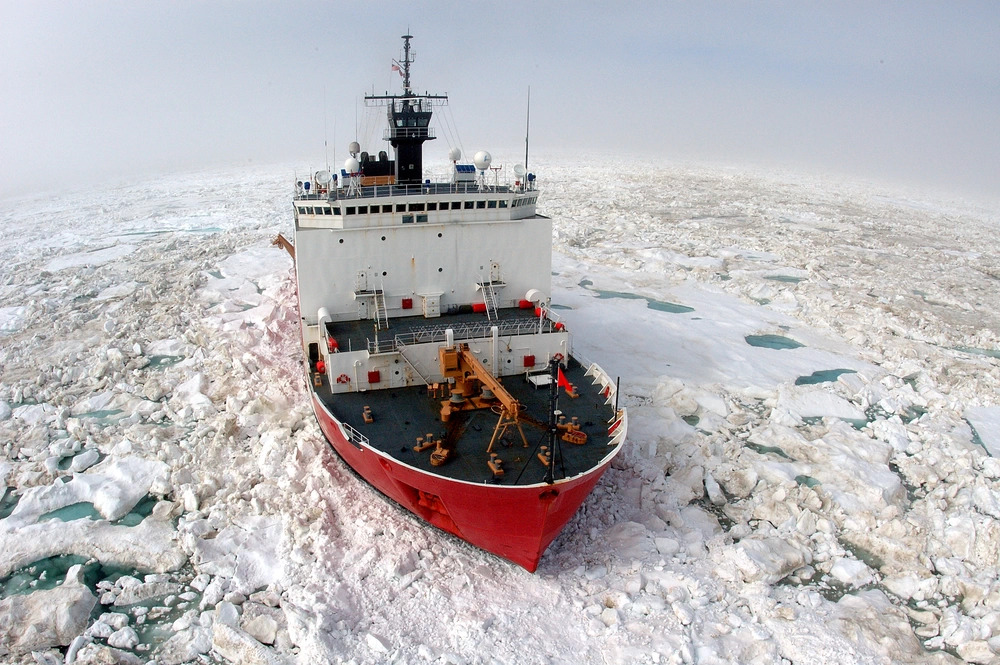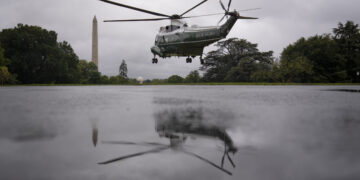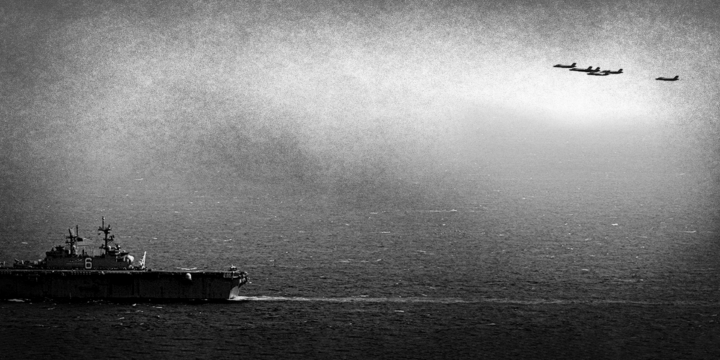Key points
- Melting ice is making the Arctic more accessible, which in turn may affect three key issues in the region: militarization, maritime trade, and natural resource development.
- U.S. security interests in the Arctic remain deterring an attack on the United States and NATO allies and ensuring the lawful use of Arctic waters. The United States can continue to secure both at minimum cost and risk.
- Greater accessibility does not increase threats emanating from the Arctic, so the United States does not need to do more militarily to ensure its security. Militarization absent threats could lead to a destabilizing security dilemma.
- Trans-Arctic maritime trade routes and natural resource development present potential economic opportunities; however, both still face significant challenges that limit their near-term viability.
- The United States should be vigilant to Russian and Chinese activity in the Arctic and avoid overreacting or reflexively mirroring their behavior. A U.S. Arctic strategy built on the reality that the United States enjoys a strong conventional and nuclear deterrent, a robust network of Arctic allies, and favorable geography, is the best avenue to protect U.S. interests and keep the Arctic at peace.
Arctic issues
The Arctic is warming at twice the rate of the rest of the globe, with ice-free summers predicted by 2034.1“Climate Change in the Arctic,” National Snow and Ice Data Center, May 4, 2020, https://nsidc.org/cryosphere/arctic-meteorology/climate_change.html. More open water increases navigability within the Arctic making military and commercial activity easier. However, this does not fundamentally alter U.S. interests in the Arctic, which include deterring attacks on the United States and NATO allies and ensuring the lawful use of Arctic waters (trade, fishing, and natural resource development). Both can be achieved at minimum additional cost and risk to the United States.
This paper analyzes three key geopolitical issues that may affect the Arctic in the coming decades: (1) militarization, (2) maritime trade, and (3) natural resource development. It also outlines recent regional activity by the United States, Russia, and China and concludes with recommendations for a prudent U.S. Arctic strategy.
Militarization
Both the United States and Russia claim a more navigable Arctic and a changing balance of power requires an increased regional military presence.2“A Strategic Blueprint for the Arctic,” U.S. Department of the Navy, 2021, https://media.defense.gov/2021/Jan/05/2002560338/-1/-1/0/ARCTIC BLUEPRINT 2021 FINAL.PDF/ARCTIC BLUEPRINT 2021 FINAL.PDF; K.M. Seethi, “Russia, US and the Churning Arctic Geopolitics-Analysis,” Eurasia Review, June 18, 2021, https://www.eurasiareview.com/18062021-russia-us-and-the-churning-arctic-geopolitics-analysis/. Increased militarization in the Arctic risks leading to a security dilemma, which in turn increases the possibility for war due to miscalculation.
Security dilemmas occur when investments in military capabilities by one country, even if they are intended as defensive in nature, are interpreted as threatening by neighboring states, who subsequently invest in their own capabilities, which spurs the first country to make further military investments—therefore exacerbating a cycle of mutual alarm. Fearing attack, states may attack preemptively—miscalculating and starting a war. Security dilemma dynamics may be already underway in the Arctic. U.S. and Russian officials have publicly expressed suspicion of one another’s military activities in the region, inflating threat perceptions.3Matthew Lee, “U.S., Russia at Odds Over Military Activity in the Arctic,” ABC News, May 20, 2021, https://abcnews.go.com/International/wireStory/us-russia-odds-military-activity-arctic-77799227.
Given the geography and harsh environmental conditions, waging war in the Arctic would be extremely costly and difficult. While the potential for direct conflict in the Arctic remains low—with no inherent reason for nations to go to war—the possibility for miscalculation or that hostilities between the great powers elsewhere in the world spill over into the region remains. For example, Russia’s invasion of Ukraine could escalate to a NATO-Russia war involving an Arctic dynamic.
Arctic military bases and facilities
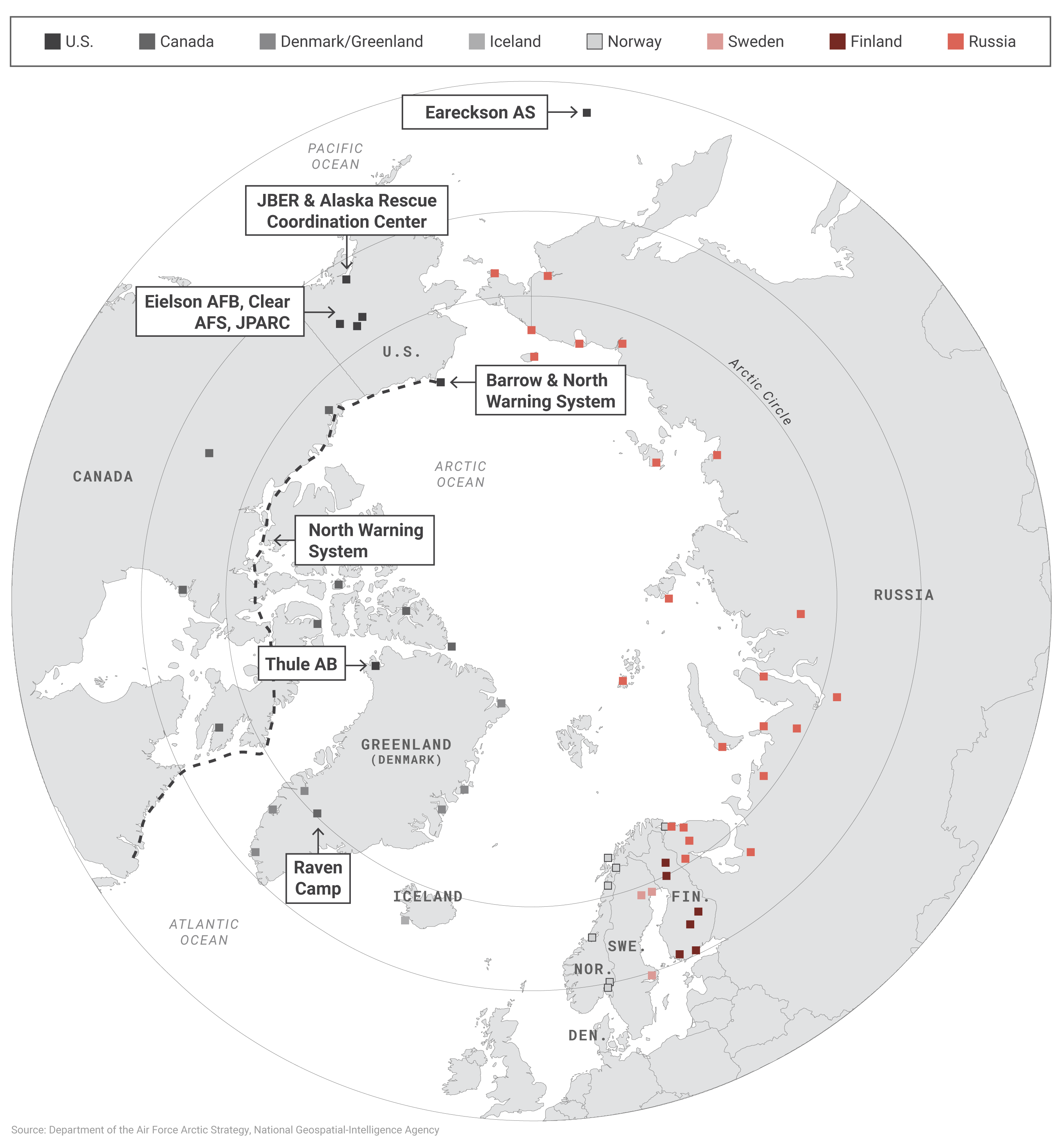
The United States maintains more than 50 early warning and missile defense radars in Alaska, Canada, and Greenland.
Currently, five Arctic states are NATO members: the United States, Canada, Denmark, Iceland, and Norway. Finland and Sweden, both of whom have hitherto adhered to a policy of military neutrality, recently declared their intention to pursue NATO membership, citing Russia’s aggression against non-NATO member Ukraine as the reason. Moscow warned it would take retaliatory measures if either country joined the alliance, further raising regional tensions.4“Neutral Finland, Sweden Warm to Idea of NATO Membership,” Associated Press, March 3, 2022, https://www.npr.org/2022/03/03/1084112625/neutral-finland-sweden-warm-to-idea-of-nato-membership.
Maritime trade
More open Arctic waters due to melting sea ice allows for greater utilization of the region’s shipping lanes. Three major trans-Arctic maritime trade routes exist; the Northern Sea Route (NSR), the Northwest Passage (NWP), and the Trans-Polar Passage (TPP). The NSR follows the northern Russian coastline, connecting north-eastern Asia with northern Europe. The NWP follows North America’s northern coastline, traversing the Canadian archipelago and connecting the Pacific and Atlantic Oceans. The TPP connects the Pacific and Atlantic by going straight through the Arctic Ocean—currently only possible with icebreaker support.
The opening of the NSR, NWP, and TPP could provide time-efficient and cost-effective alternatives to traditional maritime shipping routes. However, at present container shipping through the Arctic routes is miniscule compared to more traditional Asia-Europe routes, such as the Suez Canal route and the land-based Silk Road rail route. In 2019, the NWP saw 27 transit voyages, with 5 being general cargo ships.5Levon Sevunts, “2019 Saw Increase in Commercial Shipping Through Northwest Passage,” Radio Canada International, December 11, 2019, https://www.rcinet.ca/en/2019/12/11/2019-commercial-shipping-through-northwest-passage/. In 2020, the NSR saw 64 transit voyages, with only 2 being container ships. The remaining 62 vessels carried extracted natural resources or brought cargo to various Arctic infrastructure projects. In comparison, the Suez Canal saw close to 19,000 ships sail through it in 2020, half of which carried containers. Commercial shipping through the TPP has not occurred given the associated challenges of sailing over the North Pole, but the route remains potentially viable in the future should Arctic ice continue to melt.
Trans-Arctic maritime routes
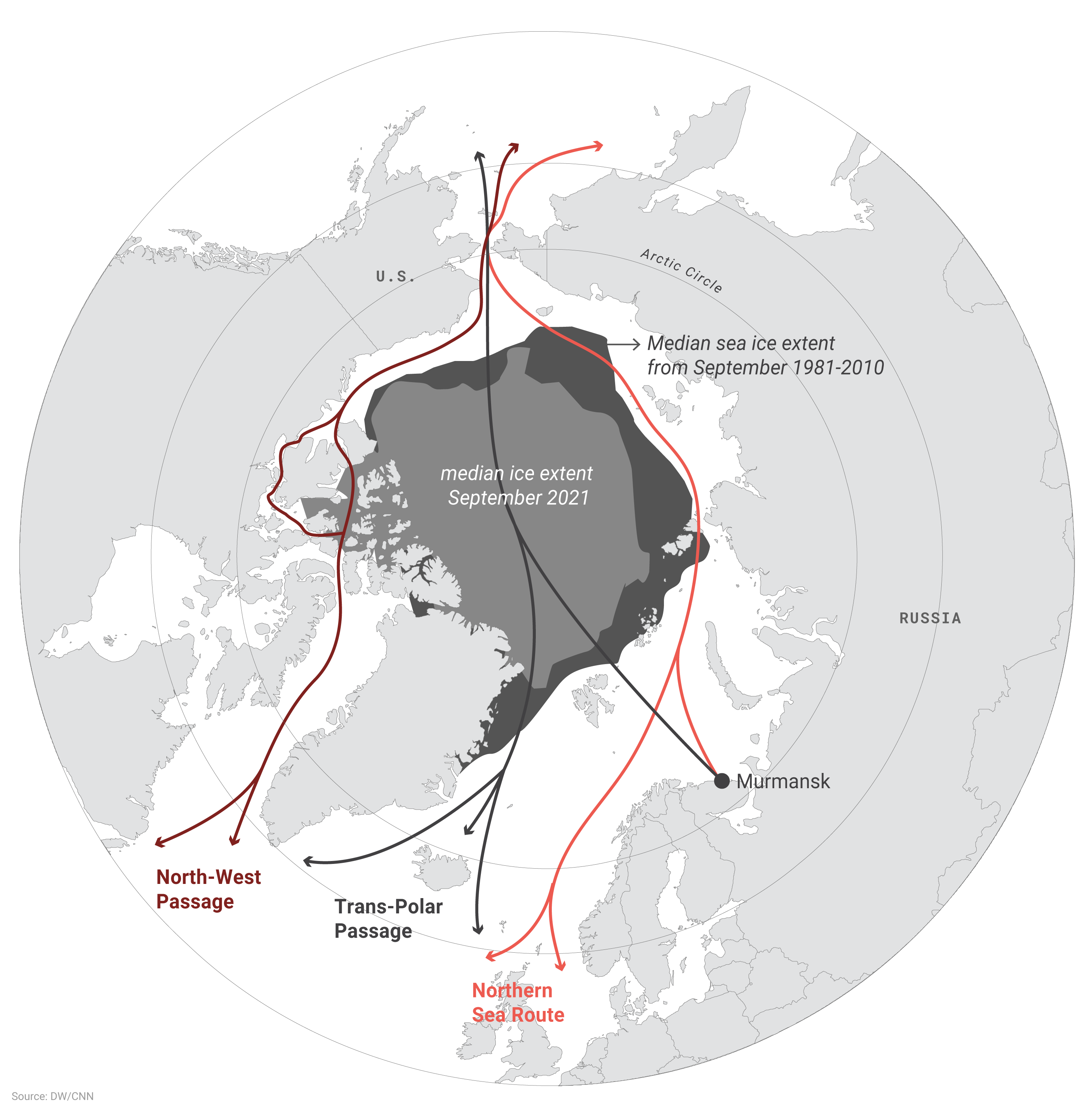
A reduction in the median ice extent increases open water for maritime traffic.
The NSR and NWP both provide a potential advantage in terms of reduced shipping times. A Shanghai-Hamburg trip through the NSR is estimated to take 18 days, compared to 20 days via the land-based Silk Road rail route and 35 days via the Suez Canal route.6“Investment Needed to Unlock NSR Potential,” AIG, October 1, 2021, https://www.aig.com/about-us/newsroom/stories/investment-needed-to-unlock-nsr-potential. However, transiting Arctic waters continues to pose substantial logistical and technical challenges due to the harsh environment, unpredictable ice accumulation, inadequate transit and communication infrastructure, the lack of search and rescue capabilities, the need for icebreaker support, and high regulatory and liability costs. These factors, among others, will likely preclude the widespread commercial use of the NSR, NWP, and TPP anytime soon.7“Investment Needed to Unlock NSR Potential,” AIG.
Natural resource development
The Arctic is rich in natural resources, including oil, natural gas, minerals, rare earth metals, and fish. Melting ice will allow greater accessibility to these resources. However, while new economic opportunities may entice investments, extracting these resources in harsh environmental conditions still presents significant challenges, limiting the near-term viability of such undertakings.
The Arctic is estimated to contain 13 percent of the world’s undiscovered oil resources (90 billion barrels) and 30 percent of its undiscovered natural gas resources (44 billion barrels of natural gas liquids and 1,669 trillion cubic feet of natural gas). In comparison, the United States maintains 38.2 billion barrels of proved oil reserves and 473 trillion cubic feet of proved natural gas reserves.8“U.S. Crude Oil and Natural Gas Reserves, Year-End 2020,” U.S. Energy Information Agency, January 13, 2022, https://www.eia.gov/naturalgas/crudeoilreserves/. Approximately 84 percent of the undiscovered oil and gas in the Arctic is estimated to be located offshore, meaning receding sea ice increases accessibility.9“Circum-Arctic Resource Appraisal: Estimates of Undiscovered Oil and Gas North of the Arctic Circle,” U.S. Geological Survey, https://pubs.usgs.gov/fs/2008/3049/fs2008-3049.pdf. Countries have an exclusive economic zone (EEZ) that extends 200 nautical miles from their shoreline, allowing them exclusive rights to the resources on or below the seabed. Countries that have ratified the U.N. Convention of the Law of the Sea (UNCLOS) may extend their EEZ up to 350 nautical miles if they can prove an extended continental shelf.10Levon Sevunts, “Russia Scores Scientific Point in Quest for Extended Arctic Continental Shelf,” Barents Observer, April 5, 2019, https://thebarentsobserver.com/en/arctic/2019/04/russia-scores-scientific-point-quest-extended-arctic-continental-shelf.
Estimated locations of oil and gas reserves in the Arctic
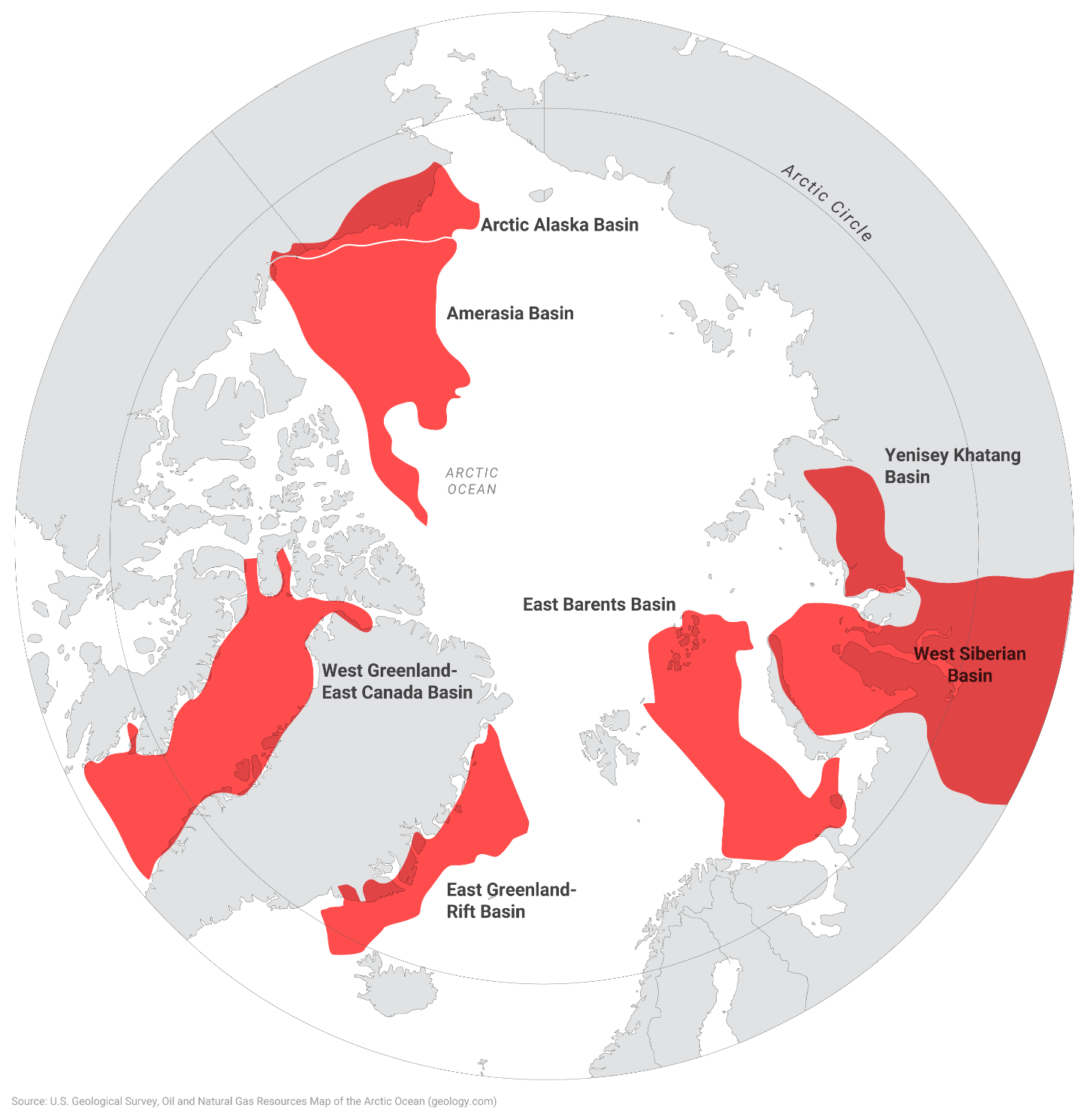
The U.S. Geological Survey estimates more than 80 percent of oil and natural gas reserves are found in seven Arctic basin provinces.
Significant challenges exist regarding oil, gas, and mineral extraction in the Arctic. First, harsh environmental conditions present logistical challenges in moving equipment and personnel to the region. Second, equipment must be able to operate in, and withstand, its severe environmental conditions. Third, thawing permafrost can lead to structures and equipment sinking into the ground. Fourth, long supply lines and intermittent transportation options require companies to maintain larger inventories of parts and supplies on hand in the case of equipment failures, which increases costs. Fifth, transportation and regulatory expenses increase the overall cost of bringing the resource to consumers.11“Arctic Oil and Natural Gas Resources,” U.S. Energy Information Administration, January 20, 2012, https://www.eia.gov/todayinenergy/detail.php?id=4650. Additionally, the global shift away from hydrocarbons toward renewable energy, and the potential for low world energy prices in general, may make efforts to extract oil and gas from the Arctic cost-inefficient.
Competing claims on Arctic oil and gas reserves could trigger inter-state disputes; however, most estimated hydrocarbon reserves lie within existing territorial boundaries, with only 4.4 percent of undiscovered oil and 1.6 percent of undiscovered gas estimated in international territory, reducing the likelihood of conflict over these resources.12Ernest Wong, “Geopolitics of Arctic Oil and Gas: The Dwindling Relevance of Territorial Claims,” New Voices in Public Policy 7, No 1, 2013.
Arctic activity
U.S. Arctic activity
The United States is an Arctic country via Alaska, which has a 1,060-mile coastline in the Arctic Ocean. U.S. Arctic interests include protecting the United States and NATO allies from attack and ensuring the lawful use of Arctic waters for trade and natural resource development.
The United States has renewed its emphasis on training forces to operate in cold-weather conditions, regularly participating in Arctic NATO exercises, including Cold Response 2022, which saw the participation of some 3,000 U.S. marines.13Jim Geraghty, “NATO Begins a ‘Cold Response’ Training Exercise in Norway Next Week,” National Review, March 10, 2022, https://www.nationalreview.com/corner/nato-begins-a-cold-response-training-exercise-in-norway-next-week/. In recent years, the United States increased bilateral cooperation with Norway, the only Arctic NATO member to share a border with Russia. In 2021 Oslo approved the construction of U.S. military facilities at three Norwegian airfields and one naval base.14KM Seethi, “Russia, the United States, and Churning Arctic Geopolitics,” The Arctic Institute, July 27, 2021, https://www.thearcticinstitute.org/russia-united-states-churning-arctic-geopolitics/; Terje Solsvik and Nerijus Adomaitis, “A New Agreement Will Allow the U.S. Military to Build on Norwegian Soil,” Reuters, April 16, 2021, https://www.reuters.com/world/europe/norway-may-allow-us-military-build-its-soil-revised-cooperation-deal-2021-04-16/. The United States is also reinforcing its military strength in Alaska, stationing 54 F-35 fighter jets at Eielson Air Force Base.15“North to the Future: F-35 and Alaska’s Strategic Mission,” F-35 Lightning II by Lockheed Martin, October 14, 2021, https://www.f35.com/f35/news-and-features/north-to-the-future-f35-and-alaskas-strategic-mission.html. With two squadrons of F-22’s stationed at Joint Base Elmendorf-Richardson, Alaska is home to more fifth-generation fighter jets than anywhere else in the world, making it relevant to projecting power into the Arctic, Europe, and Indo-Pacific.16“Arctic Strategy,” U.S. Department of the Air Force, July 21, 2020, https://www.airforcemag.com/app/uploads/2020/07/ArcticStrategy.pdf.
Congress recently appropriated funds for the U.S. Coast Guard to procure six polar icebreakers—three heavy (capable of breaking through 10-foot-thick ice) and three medium (capable of breaking through 8-foot-thick ice). The Coast Guard currently operates one heavy and one medium icebreaker. In comparison, Russia maintains more than 40 icebreakers, while China matches the United States with two.17Ronald O’Rourke, “Coast Guard Polar Security Cutter (Polar Icebreaker) Program: Background and Issues for Congress,” Congressional Research Service, December 7, 2021, https://sgp.fas.org/crs/weapons/RL34391.pdf. As an Arctic nation, a modest increase in the U.S. icebreaker fleet may be warranted to support U.S. coastguard missions and commercial activity; however, the United States does not need parity with the Russian icebreaker fleet (at a cost of tens of billions of dollars), given its far shorter Arctic coast, nor does it need to maintain a quantitative advantage over China’s icebreaker fleet to secure U.S. interests in the region. Russia’s Arctic geography necessitates it maintain a sizeable icebreaker fleet, whereas China seeks the capability to access the NSR without relying entirely on Russian support. Moreover, if needed, the United States can leverage allied Arctic allies for icebreaker support.
The United States does not currently utilize Arctic maritime trade routes to any great extent; however, the NWP in particular provides opportunities to reduce shipping times from its east coast to Asia and its west coast to Europe. Notably, the United States does not recognize Canada’s claim that the NWP consists of internal Canadian waters. The United States must resolve this dispute before widespread commercial use of the route becomes possible.18Zoë Schlanger, “The U.S. is Picking a Fight With Canada Over a Thawing Arctic Shipping Route,” Quartz, June 27, 2019, https://qz.com/1653831/the-us-is-picking-a-fight-with-canada-over-an-arctic-shipping-route/.
U.S. Arctic territory is rich in natural resources, and the U.S. Exclusive Economic Zone there encompasses some 889,000 square miles.19Ronald O’Rourke, Laura B. Comay, John Frittelli, Caitlin Keating-Bitonti, Jane A. Leggett, Jonathan L. Ramseur, Pervaze A. Sheikh, and Brandson S. Tracy, “Changes in the Arctic: Background and Issues for Congress,” Congressional Research Service, March 24, 2022, https://sgp.fas.org/crs/misc/R41153.pdf. Alaska’s North Slope contains 6 of the 100 largest oil fields in the United States and one of the largest natural gas fields.20“Alaska State Profile and Energy Estimates,” U.S. Energy Information Administration, January 21, 2021, https://www.eia.gov/state/analysis.php?sid=AK. Further hydrocarbon extraction in northern Alaska, however, has brought with it contentious domestic political battles. The Arctic National Wildlife Refuge (ANWR), for example, is estimated to contain 11 billion barrels of oil; however, environmental advocacy and indigenous groups have strongly protested energy projects in the area. Whereas the Trump Administration put oil drilling leases in ANWR for sale, the Biden Administration suspended all leasing.21“Alaska: Biden to Suspend Trump Arctic Drilling Leases,” BBC, June 2, 2021, https://www.bbc.com/news/world-us-canada-57322511.
Russia’s Arctic activity
Russia’s Arctic coastline stretches some 15,000 miles from the Barents Sea in the west to the Bering Sea and the Sea of Okhotsk in the east.22“Russia,” The Arctic Institute, June 19, 2020, https://www.thearcticinstitute.org/countries/russia/. Given the vast exposure of its northern border, Russia seeks to bolster its national defense as ice melts. Russia also aims to increase its economic prosperity through trade and natural resource extraction in the Arctic.
Russia has increased its military presence in the region by refurbishing former Soviet Arctic bases, airfields, and radar installations and stationing modern military assets on them, including ballistic missiles, anti-ship missiles, and missile defense systems.23Nick Palton Walsh, “Satellite Images Show Huge Russian Military Buildup in the Arctic,” CNN, April 5, 2021, https://www.cnn.com/2021/04/05/europe/russia-arctic-nato-military-intl-cmd/index.html. Russia’s Northern Fleet is responsible for Arctic operations and maintains its headquarters in Severomorsk on the Kola Peninsula. Defending the Kola Peninsula is a core Russian security interest, as it serves as the home of its ballistic missile submarine fleet, key to its secure nuclear second-strike capability.
Russian efforts to establish multi-layered anti-access, area-denial (A2/AD) capabilities indicate a defensive posture.24Mathieu Boulègue, “Russia’s Military Posture in the Arctic,”Russia’s Military Posture in the Arctic,” Chatham House, June 28, 2019, https://www.chathamhouse.org/2019/06/russias-military-posture-arctic. After years of neglect, Russia’s renewed interest in the Arctic signals an attempt to return to the defensive bastion strategy of the Soviet Union, not an unprecedented escalation. As such, Russia seeks to protect its Northern Fleet and secure its nuclear second-strike capabilities, its increasingly accessible northern border, and its economic interests along the NSR. None of these pose a direct threat to the United States. Moreover, modern Russia is much weaker than the Soviet Union—and getting weaker from its invasion of Ukraine—and the United States’ assessment of the threat it poses should reflect this reality.
A key component of Russia’s Arctic economic strategy is the utilization of the NSR to access international markets. Russia claims the NSR as an internal waterway and implements disputed restrictions on foreign naval and commercial vessels.25Russia mandates foreign states send notification about warships transiting the NSR at least 45 days in advance, including the name of the ship and its captain; its objective and planned route; and the ships characteristics such as length, width, deadweight, draft, and engine type. Ships are also required to permit a Russian maritime pilot on board. Russia maintains the right to halt, arrest, or even eliminate foreign vessels that do not abide by these rules. Russia’s 2035 Arctic Strategy suggests that Moscow views the utilization of the NSR by Russian companies delivering energy resources to global markets as more viable than international transit. By 2035, Russia projects the NSR to see 130 million tons of throughput, only 10 million of which will consist of international transit.26“Strategy of Development of the Arctic Zone of the Russian Federation and the Provision of National Security for the Period to 2035,” NATO, June 25, 2021, https://www.ndc.nato.int/research/research.php?icode=703#. Russia’s increased international isolation and the West’s shift away from Russian energy imports following its invasion of Ukraine will undoubtedly affect these predictions.
Russia maintains substantial economic interests in the Arctic. Regional projects account for 10 percent of Russia’s GDP, and 20 percent of its exports are produced there. Natural gas, oil, mineral extraction, and timber are key drivers of Russia’s Arctic economy. Russia extracts more than 90 percent of its natural gas and 17 percent of its oil in the Arctic.27Janis Kluge and Michael Paul, “Russia’s Arctic Strategy Through 2035,” Foundation Science and Politics, German Institute for International Politics and Security [Stiftung Wissenschaft und Politik, Deutsches Institut für Internationale Politik und Sicherheit], November 2020, https://www.swp-berlin.org/publications/products/comments/2020C57_RussiaArcticStrategy.pdf. Russia’s Yamal LNG and its planned LNG 2 projects alone are estimated to produce 37.5 million tons of LNG per year.28Malte Humpert, “China Continues to Invest in Arctic Natural Resources As Two Chinese National Oil Companies Secure a 20 Percent Stake in Russia’s Massive Arctic LNG 2 Project,” High North News, April 29, 2019, https://www.highnorthnews.com/en/china-acquires-20-percent-stake-novateks-latest-arctic-lng-project. Moreover, Russia’s Arctic territory is estimated to contain $1.5 to $2 trillion of solid minerals such as rare earth metals, diamonds, gold, titanium, quartz, and coal. Russia’s 2035 Arctic Strategy calls for the construction of 21 projects to extract solid minerals to be completed by 2035.29Mark Rowe, “Dossier: Mining the Arctic,” Geographical, August 6, 2021, https://geographical.co.uk/nature/polar/item/4113-dossier-mining-the-arctic; “Strategy of Development of the Arctic Zone of the Russian Federation and the Provision of National Security for the Period to 2035,” NATO.
China’s Arctic activity
In 2018, China released its Polar Strategy in which it claimed to be a “near-Arctic” power despite being 5,000 nautical miles away from the Bering Strait. China was granted permanent observer status to the Arctic Council in 2013 and has subsequently focused on expanding its influence in the region through diplomacy, economic investment, and scientific research. China’s Arctic strategy focuses primarily on the economic opportunities it envisions through the establishment of the Polar Silk-Road, part of its global Belt and Road initiative.
China does not currently have a military presence in the Arctic. U.S. policymakers would be wise to realistically assess China’s Arctic military capabilities and aspirations, making sure not to overstate a potential threat. Chinese submarines currently lack the capability to sail in the Arctic undetected, and while such a development in the future would be unwelcome, the threat it poses would not differ from Chinese submarines already operating elsewhere in the world’s oceans. A hypothetical Chinese threat is further reduced when geography is considered. As a non-Arctic state, China faces the challenge of accessing the Arctic. If needed, the U.S. Navy could cut off China’s access to the region by contesting key straits, such as the Bering Strait separating Russia and Alaska and the La Pérouse Strait separating the Russian island of Sakhalin from the Japanese island of Hokkaido.
To the extent China may seek to utilize the region for security purposes, it will likely come in the form of attempts to gain influence and establish dual-use projects for intelligence gathering.30Nikolaj Skydsgaard, Jacob Gronholt-Pedersen, and Stine Jacobsen, “China Mixing Military and Science in Arctic Push: Denmark,” Reuters, November 29, 2019, https://www.reuters.com/article/us-usa-arctic/china-mixing-military-and-science-in-arctic-push-denmark-idUSKBN1Y3116. China has focused on diplomatic outreach to other Arctic nations by establishing joint research projects and sponsoring Arctic forums.31Trym Aleksander Eiterjord, “China’s Busy Year in the Arctic,” Diplomat, January 30, 2019, https://thediplomat.com/2019/01/chinas-busy-year-in-the-arctic/. China constructed research stations on the Norwegian Svalbard islands in 2003, Sweden in 2016, and Iceland in 2018.32“China,” The Arctic Institute, June 19, 2020, https://www.thearcticinstitute.org/countries/china/. With deteriorating relations between the West and China, Chinese regional investments have received greater scrutiny. For example, China’s Polar Research Institute offered to buy or rent a Finnish airport in 2018, claiming its intentions were to conduct Arctic research flights over the North Pole. Finland subsequently rejected the offer citing security concerns.33Thomas Nilsen, “Finland’s Military Blocked a Chinese Bid to Buy an Arctic Airport for Climate Research Flights,” Arctic Today, March 5, 2021, https://www.arctictoday.com/finlands-military-blocked-a-chinese-bid-to-buy-an-arctic-airport-for-climate-research-flights/.
China seeks to utilize the NSR as a maritime trade route reducing shipping times to Europe. In this pursuit, China has formed a mutually beneficial relationship with Russia by investing in transit and communication infrastructure along the NSR. China is planning to invest in several Arctic ports, including a deep-water port at Arkhangelsk. The port is expected to link with Russian railway networks that could connect the Arctic to Central Asia.34Thomas Nilsen, “New Barents Sea Port and 500 KM Railway Link Could Help Connect Asia with the Arctic,” Barents Observer, May 27, 2020, https://thebarentsobserver.com/en/arctic/2020/05/new-barents-sea-port-will-get-railway-connecting-asia-arctic.
China is also interested in financing Russian energy projects with Chinese companies having a 20 percent stake in both the Yamal LNG and LNG 2 projects in Russia. Oil and gas reserves in the Arctic have a geopolitical benefit for China, allowing it to receive hydrocarbons from an alternate route if traditional maritime routes in the western Pacific are blocked. China relies heavily on these traditional routes, with an estimated 77 percent of its oil imports and 10 percent of its natural gas imports in 2019 being transited via the South China Sea and the Strait of Malacca.35“Military and Security Developments Involving the People’s Republic of China Annual Report to Congress,” Department of Defense, 2020, https://media.defense.gov/2020/Sep/01/2002488689/-1/-1/1/2020-DOD-CHINA-MILITARY-POWER-REPORT-FINAL.PDF.
What does a prudent U.S.-Arctic strategy look like?
The United States does not need to do more militarily in the Arctic to ensure its security. A restraint-oriented approach that avoids militarizing the Arctic through permanent deployments will allow finite U.S. resources to be deployed to other key regions and lowers the chance of miscalculation. Competition with Russia and China elsewhere in the world should not prompt the United States to exaggerate the threat it faces from either in the Arctic.
U.S. conventional and nuclear capabilities—the strongest deterrent in existence—mitigate the threat of a direct attack on the United States or NATO allies. Conventional deterrence is maintained via the U.S. early warning and missile defense system and the ability to surge forces capable of operating in Arctic conditions to strategic chokepoints, such as the Bering Strait, the Greenland, Iceland, United Kingdom (GIUK) gap, and the Bear gap located between the Svalbard Islands and Norway.
Arctic geography dictates that a conventional military deterrent would primarily encompass the projection of air and naval power, particularly submarines, of which the United States enjoys a qualitative advantage over both Russia and China—neither of which are currently constrained by the level of ice in the Arctic, particularly submarines.
Strategic Arctic chokepoints
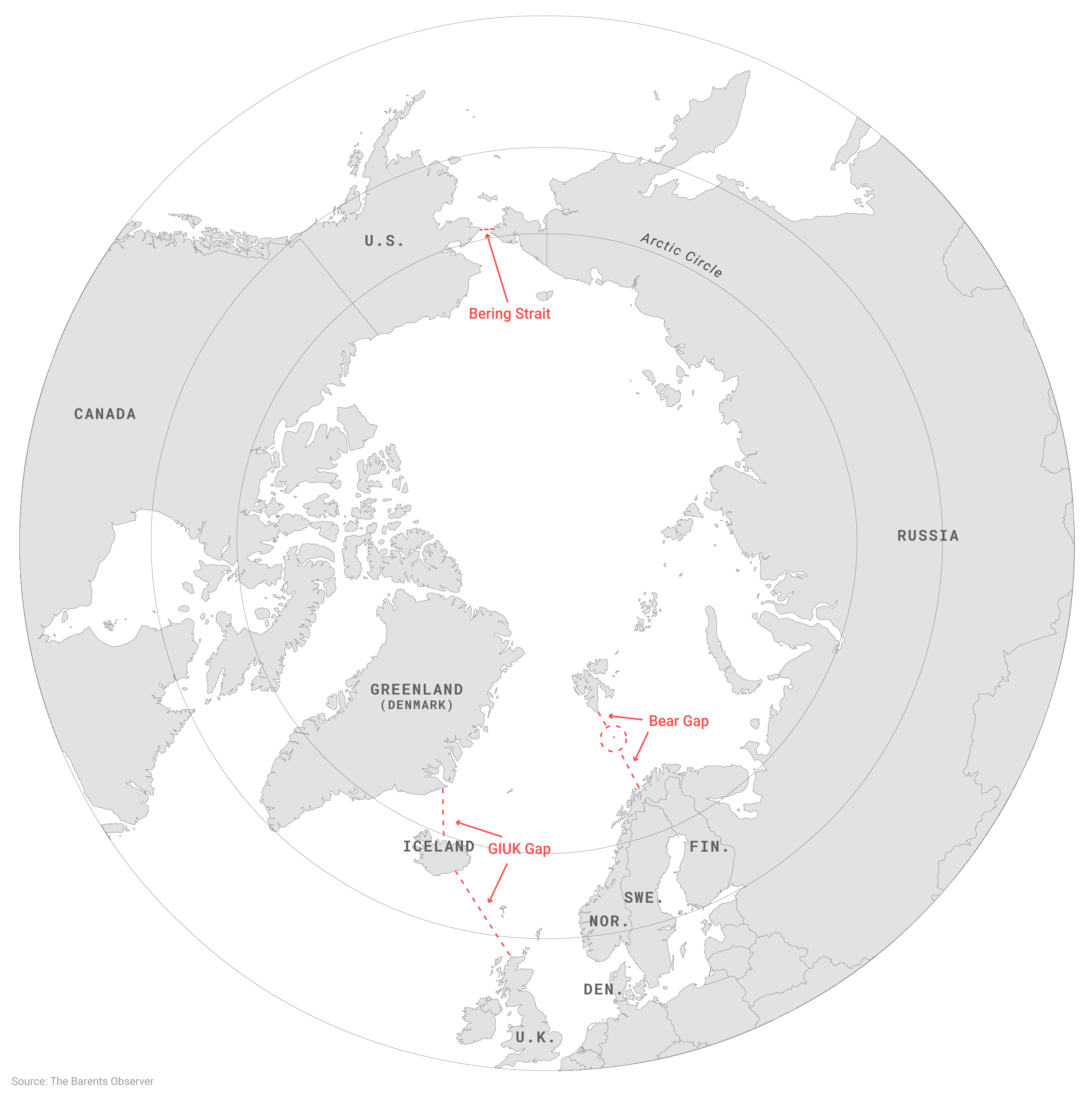
The Bering Strait, GIUK Gap, and Bear Gap, present a geographical challenge for Russian naval forces to exit and for Chinese naval forces to enter the Arctic.
The United States’ Arctic economic strategy should be opportunistic. As trans-Arctic maritime routes become more viable, they could provide cost-effective reductions in shipping times for U.S. companies. The NWP in particular could expedite the shipment of U.S. goods to Asia and Europe. The United States could consider pursuing cooperation with Canada to invest in the necessary transit infrastructure to make large scale maritime traffic feasible. Subsequently, joint public-private partnerships may provide an opportunity to pursue oil, natural gas, and mineral extraction projects that reduce U.S. dependency on other countries.
The Arctic landscape is changing, but U.S. regional interests endure. The United States should monitor Russian and Chinese activity in the Arctic but take care not to overreact or mirror their behavior. A U.S. Arctic strategy built on the reality that the United States enjoys a strong conventional and nuclear deterrent, a robust network of Arctic allies, and favorable geography is the best avenue to protect U.S. interests and keep the Arctic at peace.
Endnotes
- 1“Climate Change in the Arctic,” National Snow and Ice Data Center, May 4, 2020, https://nsidc.org/cryosphere/arctic-meteorology/climate_change.html.
- 2“A Strategic Blueprint for the Arctic,” U.S. Department of the Navy, 2021, https://media.defense.gov/2021/Jan/05/2002560338/-1/-1/0/ARCTIC BLUEPRINT 2021 FINAL.PDF/ARCTIC BLUEPRINT 2021 FINAL.PDF; K.M. Seethi, “Russia, US and the Churning Arctic Geopolitics-Analysis,” Eurasia Review, June 18, 2021, https://www.eurasiareview.com/18062021-russia-us-and-the-churning-arctic-geopolitics-analysis/.
- 3Matthew Lee, “U.S., Russia at Odds Over Military Activity in the Arctic,” ABC News, May 20, 2021, https://abcnews.go.com/International/wireStory/us-russia-odds-military-activity-arctic-77799227.
- 4“Neutral Finland, Sweden Warm to Idea of NATO Membership,” Associated Press, March 3, 2022, https://www.npr.org/2022/03/03/1084112625/neutral-finland-sweden-warm-to-idea-of-nato-membership.
- 5Levon Sevunts, “2019 Saw Increase in Commercial Shipping Through Northwest Passage,” Radio Canada International, December 11, 2019, https://www.rcinet.ca/en/2019/12/11/2019-commercial-shipping-through-northwest-passage/.
- 6“Investment Needed to Unlock NSR Potential,” AIG, October 1, 2021, https://www.aig.com/about-us/newsroom/stories/investment-needed-to-unlock-nsr-potential.
- 7“Investment Needed to Unlock NSR Potential,” AIG.
- 8“U.S. Crude Oil and Natural Gas Reserves, Year-End 2020,” U.S. Energy Information Agency, January 13, 2022, https://www.eia.gov/naturalgas/crudeoilreserves/.
- 9“Circum-Arctic Resource Appraisal: Estimates of Undiscovered Oil and Gas North of the Arctic Circle,” U.S. Geological Survey, https://pubs.usgs.gov/fs/2008/3049/fs2008-3049.pdf.
- 10Levon Sevunts, “Russia Scores Scientific Point in Quest for Extended Arctic Continental Shelf,” Barents Observer, April 5, 2019, https://thebarentsobserver.com/en/arctic/2019/04/russia-scores-scientific-point-quest-extended-arctic-continental-shelf.
- 11“Arctic Oil and Natural Gas Resources,” U.S. Energy Information Administration, January 20, 2012, https://www.eia.gov/todayinenergy/detail.php?id=4650.
- 12Ernest Wong, “Geopolitics of Arctic Oil and Gas: The Dwindling Relevance of Territorial Claims,” New Voices in Public Policy 7, No 1, 2013.
- 13Jim Geraghty, “NATO Begins a ‘Cold Response’ Training Exercise in Norway Next Week,” National Review, March 10, 2022, https://www.nationalreview.com/corner/nato-begins-a-cold-response-training-exercise-in-norway-next-week/.
- 14KM Seethi, “Russia, the United States, and Churning Arctic Geopolitics,” The Arctic Institute, July 27, 2021, https://www.thearcticinstitute.org/russia-united-states-churning-arctic-geopolitics/; Terje Solsvik and Nerijus Adomaitis, “A New Agreement Will Allow the U.S. Military to Build on Norwegian Soil,” Reuters, April 16, 2021, https://www.reuters.com/world/europe/norway-may-allow-us-military-build-its-soil-revised-cooperation-deal-2021-04-16/.
- 15“North to the Future: F-35 and Alaska’s Strategic Mission,” F-35 Lightning II by Lockheed Martin, October 14, 2021, https://www.f35.com/f35/news-and-features/north-to-the-future-f35-and-alaskas-strategic-mission.html.
- 16“Arctic Strategy,” U.S. Department of the Air Force, July 21, 2020, https://www.airforcemag.com/app/uploads/2020/07/ArcticStrategy.pdf.
- 17Ronald O’Rourke, “Coast Guard Polar Security Cutter (Polar Icebreaker) Program: Background and Issues for Congress,” Congressional Research Service, December 7, 2021, https://sgp.fas.org/crs/weapons/RL34391.pdf.
- 18Zoë Schlanger, “The U.S. is Picking a Fight With Canada Over a Thawing Arctic Shipping Route,” Quartz, June 27, 2019, https://qz.com/1653831/the-us-is-picking-a-fight-with-canada-over-an-arctic-shipping-route/.
- 19Ronald O’Rourke, Laura B. Comay, John Frittelli, Caitlin Keating-Bitonti, Jane A. Leggett, Jonathan L. Ramseur, Pervaze A. Sheikh, and Brandson S. Tracy, “Changes in the Arctic: Background and Issues for Congress,” Congressional Research Service, March 24, 2022, https://sgp.fas.org/crs/misc/R41153.pdf.
- 20“Alaska State Profile and Energy Estimates,” U.S. Energy Information Administration, January 21, 2021, https://www.eia.gov/state/analysis.php?sid=AK.
- 21“Alaska: Biden to Suspend Trump Arctic Drilling Leases,” BBC, June 2, 2021, https://www.bbc.com/news/world-us-canada-57322511.
- 22“Russia,” The Arctic Institute, June 19, 2020, https://www.thearcticinstitute.org/countries/russia/.
- 23Nick Palton Walsh, “Satellite Images Show Huge Russian Military Buildup in the Arctic,” CNN, April 5, 2021, https://www.cnn.com/2021/04/05/europe/russia-arctic-nato-military-intl-cmd/index.html.
- 24Mathieu Boulègue, “Russia’s Military Posture in the Arctic,”Russia’s Military Posture in the Arctic,” Chatham House, June 28, 2019, https://www.chathamhouse.org/2019/06/russias-military-posture-arctic.
- 25Russia mandates foreign states send notification about warships transiting the NSR at least 45 days in advance, including the name of the ship and its captain; its objective and planned route; and the ships characteristics such as length, width, deadweight, draft, and engine type. Ships are also required to permit a Russian maritime pilot on board. Russia maintains the right to halt, arrest, or even eliminate foreign vessels that do not abide by these rules.
- 26“Strategy of Development of the Arctic Zone of the Russian Federation and the Provision of National Security for the Period to 2035,” NATO, June 25, 2021, https://www.ndc.nato.int/research/research.php?icode=703#.
- 27Janis Kluge and Michael Paul, “Russia’s Arctic Strategy Through 2035,” Foundation Science and Politics, German Institute for International Politics and Security [Stiftung Wissenschaft und Politik, Deutsches Institut für Internationale Politik und Sicherheit], November 2020, https://www.swp-berlin.org/publications/products/comments/2020C57_RussiaArcticStrategy.pdf.
- 28Malte Humpert, “China Continues to Invest in Arctic Natural Resources As Two Chinese National Oil Companies Secure a 20 Percent Stake in Russia’s Massive Arctic LNG 2 Project,” High North News, April 29, 2019, https://www.highnorthnews.com/en/china-acquires-20-percent-stake-novateks-latest-arctic-lng-project.
- 29Mark Rowe, “Dossier: Mining the Arctic,” Geographical, August 6, 2021, https://geographical.co.uk/nature/polar/item/4113-dossier-mining-the-arctic; “Strategy of Development of the Arctic Zone of the Russian Federation and the Provision of National Security for the Period to 2035,” NATO.
- 30Nikolaj Skydsgaard, Jacob Gronholt-Pedersen, and Stine Jacobsen, “China Mixing Military and Science in Arctic Push: Denmark,” Reuters, November 29, 2019, https://www.reuters.com/article/us-usa-arctic/china-mixing-military-and-science-in-arctic-push-denmark-idUSKBN1Y3116.
- 31Trym Aleksander Eiterjord, “China’s Busy Year in the Arctic,” Diplomat, January 30, 2019, https://thediplomat.com/2019/01/chinas-busy-year-in-the-arctic/.
- 32“China,” The Arctic Institute, June 19, 2020, https://www.thearcticinstitute.org/countries/china/.
- 33Thomas Nilsen, “Finland’s Military Blocked a Chinese Bid to Buy an Arctic Airport for Climate Research Flights,” Arctic Today, March 5, 2021, https://www.arctictoday.com/finlands-military-blocked-a-chinese-bid-to-buy-an-arctic-airport-for-climate-research-flights/.
- 34Thomas Nilsen, “New Barents Sea Port and 500 KM Railway Link Could Help Connect Asia with the Arctic,” Barents Observer, May 27, 2020, https://thebarentsobserver.com/en/arctic/2020/05/new-barents-sea-port-will-get-railway-connecting-asia-arctic.
- 35“Military and Security Developments Involving the People’s Republic of China Annual Report to Congress,” Department of Defense, 2020, https://media.defense.gov/2020/Sep/01/2002488689/-1/-1/1/2020-DOD-CHINA-MILITARY-POWER-REPORT-FINAL.PDF.
The Latest

January 13, 2026
Events on Grand strategy

